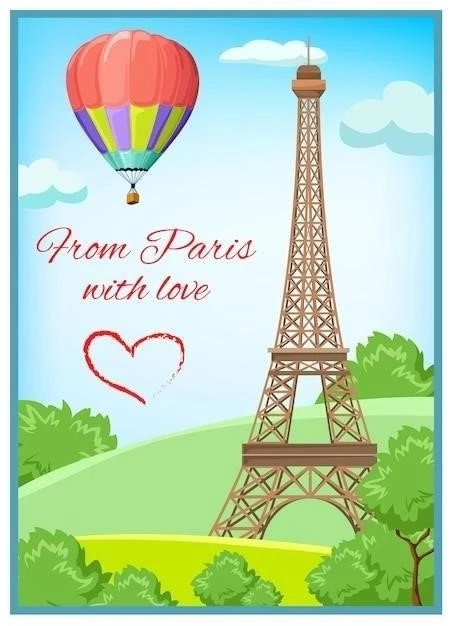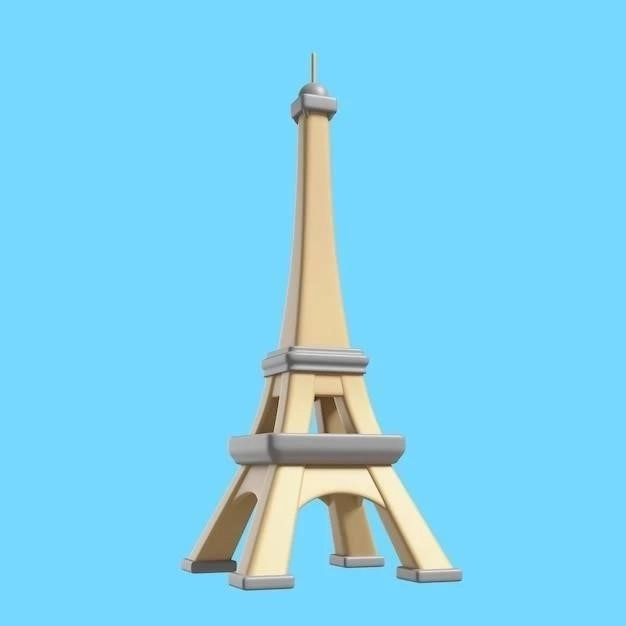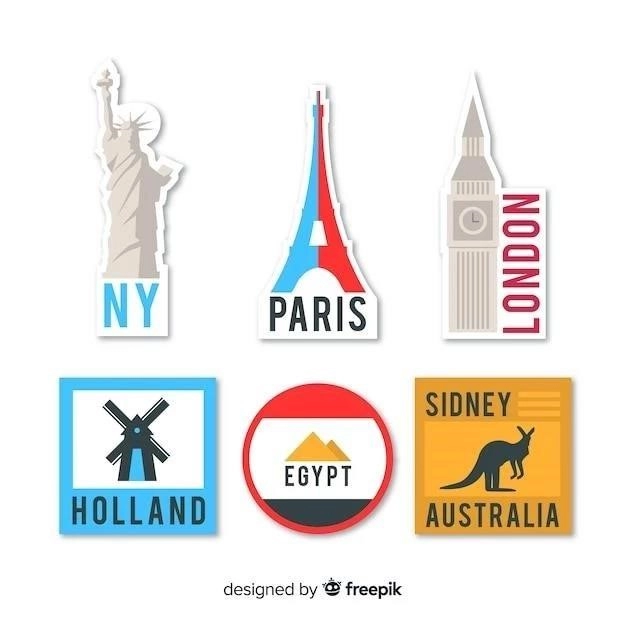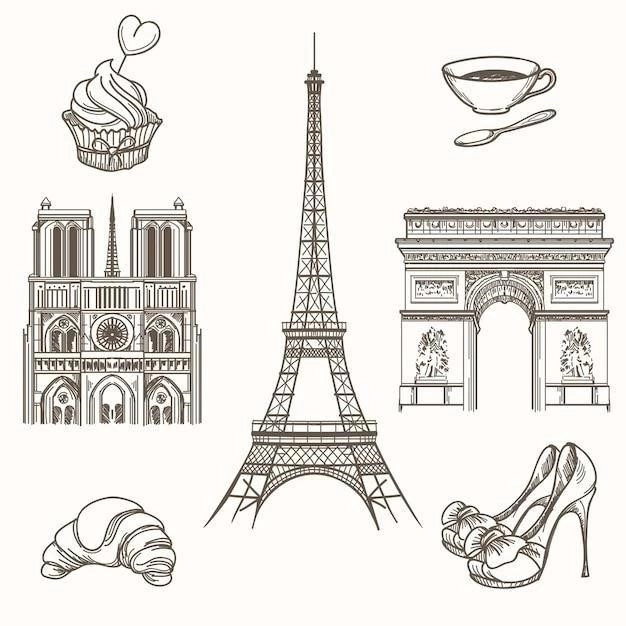The Eiffel Tower: A Timeless Symbol of Paris
The Eiffel Tower, or La Tour Eiffel, stands as a globally recognized icon of Paris and France. Constructed between 1887 and 1889٫ this wrought-iron lattice tower takes its name from the engineer Gustave Eiffel٫ whose company spearheaded its design and construction. More than just a structure٫ the Eiffel Tower embodies architectural ingenuity٫ historical significance٫ and enduring cultural impact.
Conception and Construction
The genesis of the Eiffel Tower can be traced back to the planning of the 1889 World’s Fair, or Exposition Universelle, a momentous event intended to celebrate the centennial of the French Revolution and showcase France’s industrial prowess to the world. In 1884, the idea for a 300-meter tower was formulated, eventually leading to a competition to select the centerpiece for the fair. Among 107 proposals, it was the audacious design by Gustave Eiffel’s engineering firm, spearheaded by Maurice Koechlin and Émile Nouguier, that captured the attention of the jury.
Eiffel’s design, initially dubbed the “300-meter Tower,” was a testament to innovative engineering and architectural daring. It called for a wrought-iron lattice structure, a material more commonly used in bridge construction at the time. This choice was not only aesthetically striking but also structurally sound, allowing the tower to withstand wind forces and distribute its weight efficiently. To enhance its visual appeal and address concerns about its industrial aesthetic, architect Stephen Sauvestre was brought on board to refine the tower’s appearance, adding decorative arches, a glass pavilion on the first level, and a distinctive silhouette that would become instantly recognizable.

Construction of the Eiffel Tower commenced on January 28, 1887, on the Champ de Mars, a sprawling green space near the Seine River. The project was a remarkable feat of engineering and logistics. Over 18,000 pieces of wrought iron, each meticulously calculated and fabricated at Eiffel’s factory on the outskirts of Paris, were transported to the site. There, a team of skilled workers, numbering around 300, painstakingly assembled the tower using over 2.5 million rivets.
The construction process itself was a marvel of precision and speed, especially considering the technological limitations of the time. Large cranes, some built specifically for the project, hoisted pre-assembled sections of the tower into place, where they were connected with rivets hammered in by hand and secured with temporary bolts. As the tower rose, a system of wooden scaffolding and temporary elevators supported the workers and materials. Gustave Eiffel himself closely oversaw every stage of the construction, employing innovative safety measures and rigorous quality control. Despite the inherent risks involved in erecting such a massive structure, the project was completed in a remarkably short period of two years, two months, and five days, with only one fatality recorded during the entire construction period.
The Eiffel Tower was finished on March 31, 1889, just in time for the grand opening of the World’s Fair on May 6th. It stood as a testament to the ambition, engineering prowess, and artistic vision of its creators, forever changing the Parisian skyline and becoming an enduring symbol of human ingenuity.
The Architectural Significance of the Eiffel Tower
The Eiffel Tower stands as a seminal work in the history of architecture, embodying a pivotal moment in the evolution of structural design and aesthetic sensibilities. It marked a decisive break from traditional architectural norms, embracing new materials and construction techniques that would shape the course of modern architecture.
One of the tower’s most significant architectural contributions was its pioneering use of wrought iron on a monumental scale. While iron had been employed in bridge building and industrial structures, the Eiffel Tower demonstrated its viability as a primary material for grand architectural statements. The tower’s intricate lattice structure, composed of thousands of prefabricated iron components bolted and riveted together, showcased the material’s strength, lightness, and versatility. This innovative use of iron paved the way for the development of steel-frame construction, a technique that would revolutionize building practices in the coming decades, enabling the construction of skyscrapers and other large-scale structures.
Beyond its structural innovations, the Eiffel Tower also challenged prevailing architectural aesthetics. Its soaring verticality, open latticework, and exposed skeletal frame deviated sharply from the ornate, masonry-heavy styles that dominated 19th-century architecture. The tower’s form followed its function, its design dictated by structural requirements and wind resistance. This embrace of functionalism, where aesthetic considerations were subordinate to engineering principles, foreshadowed the modernist movement in architecture, which would emerge in the early 20th century.
Despite initial criticism from some quarters who considered it an eyesore, the Eiffel Tower’s unique aesthetic gradually gained acceptance and admiration. Its elegant curves, delicate tracery, and harmonious proportions, enhanced by Stephen Sauvestre’s decorative embellishments, imbued the structure with an undeniable visual appeal. The tower’s distinctive silhouette, instantly recognizable from afar, became an iconic symbol of Paris and a testament to the beauty that could be achieved through innovative engineering and a willingness to embrace new architectural forms.
The Eiffel Tower’s architectural legacy extends beyond its immediate impact on structural design and aesthetic sensibilities. It served as a tangible symbol of the technological advancements of the Industrial Revolution, showcasing the potential of new materials and construction techniques. Moreover, the tower’s enduring popularity helped to legitimize iron and steel as viable and aesthetically pleasing building materials, inspiring generations of architects and engineers to explore their creative possibilities. In essence, the Eiffel Tower stands as a timeless masterpiece that continues to inspire and influence architectural discourse, a testament to the power of human ingenuity and the enduring allure of innovative design.
The Eiffel Tower and the 1889 World’s Fair
The Eiffel Tower’s destiny has been inextricably linked to the 1889 World’s Fair from its inception. Conceived as the centerpiece of this grand international exposition, the tower served as a potent symbol of France’s industrial might and cultural dynamism at the time. The World’s Fair, held in Paris from May 6 to October 31, 1889, was a momentous occasion, attracting millions of visitors from around the globe eager to witness the latest innovations in science, technology, and art.
The Eiffel Tower, even during its construction phase, became a focal point of the fair, capturing the imagination of the public and generating intense interest. Its towering presence dominated the Champ de Mars, dwarfing the other exhibition halls and pavilions. Visitors flocked to marvel at its unprecedented scale and audacious design, making it the undisputed star attraction of the fair.
The tower’s elevators, cutting-edge technology for their time, transported visitors to the various observation decks, providing breathtaking panoramic views of the city and the fairgrounds below. The experience of ascending this iron colossus, coupled with the unparalleled vistas from its heights, left an indelible impression on visitors, solidifying the tower’s status as a symbol of modernity and human achievement.
Beyond its symbolic significance, the Eiffel Tower also played a practical role during the World’s Fair. It housed a variety of exhibits and concessions, including a restaurant on the first level, a printing press that produced a commemorative newspaper, and a post office where visitors could send postcards from this architectural marvel.
The 1889 World’s Fair marked a pivotal moment in the Eiffel Tower’s history. Initially granted a 20-year permit, its existence beyond the fair’s duration was uncertain. However, its immense popularity during the exposition, coupled with its potential for scientific and communication purposes, ultimately secured its preservation. The tower’s role as a beacon of progress and innovation during the fair helped to transform public opinion, establishing it as an integral part of the Parisian landscape and a symbol of France’s enduring spirit. The 1889 World’s Fair, therefore, not only provided the impetus for the Eiffel Tower’s creation but also laid the foundation for its enduring legacy as a global icon.
Public Reactions and Artistic Controversy
The Eiffel Tower, from its inception, ignited a firestorm of public debate and artistic controversy that reflected the societal shifts and evolving aesthetic values of late 19th-century France. While the tower was under construction, a vocal contingent of Parisian artists, writers, and intellectuals vehemently opposed its presence, viewing it as an affront to the city’s architectural harmony and a symbol of industrial hubris.
This opposition manifested in a public letter of protest, published in the newspaper Le Temps in February 1887, signed by prominent figures such as Guy de Maupassant, Alexandre Dumas Jr., and Charles Garnier, architect of the opulent Palais Garnier opera house. They denounced the tower as a “useless and monstrous Eiffel Tower,” a “gigantic black factory chimney” that would cast a shadow over the city’s cherished monuments and disrupt the elegant Parisian skyline. Their arguments reflected a deep-seated fear that this modern intrusion, built with industrial materials and devoid of traditional ornamentation, would irrevocably mar the beauty and character of their beloved city.
However, not all segments of Parisian society shared this view. The tower also garnered enthusiastic support, particularly from those who saw it as a symbol of France’s engineering prowess, its embrace of modernity, and its triumph over the technological challenges of the era. The public, captivated by the tower’s sheer scale and the novelty of its design, flocked to witness its construction and later ascended to its observation decks in droves.
The 1889 World’s Fair, where the tower served as the centerpiece, played a pivotal role in shaping public opinion. The exposition attracted millions of visitors from around the world, many of whom were awestruck by the tower’s imposing presence and the panoramic views it offered. The international acclaim the tower received during the fair contributed to a gradual shift in public perception, as it transformed from a controversial construction project into a source of national pride.
Over time, the Eiffel Tower transcended its initial status as a lightning rod for controversy, ultimately becoming a beloved symbol of Paris and an integral part of the city’s identity. While some of the artistic criticisms leveled against it reflected genuine concerns about the changing urban landscape, the tower’s enduring popularity speaks to its ability to capture the imagination, inspire awe, and ultimately transcend the vagaries of taste and time.
The Eiffel Tower’s Role in Communications
The Eiffel Tower, conceived as a temporary structure for the 1889 World’s Fair٫ found an unexpected and enduring purpose in the realm of communications٫ playing a pivotal role in the development of radio technology and its subsequent applications in broadcasting٫ navigation٫ and military communications.
Gustave Eiffel, a visionary engineer with a keen understanding of the tower’s potential beyond its aesthetic and symbolic value, championed its use for scientific experimentation and technological advancement. As early as 1889, he authorized the installation of a meteorological laboratory on the tower’s third level, recognizing its unique vantage point for weather observation. This early foray into scientific applications foreshadowed the tower’s future significance in the burgeoning field of wireless communication.
In 1903, with the tower’s planned demolition looming, Eiffel made a strategic decision that would secure its preservation. He proposed using the tower as a giant antenna for wireless telegraphy, a technology then in its infancy. The French military, recognizing the strategic advantages of long-range communication, agreed to fund the installation of a powerful radio transmitter on the tower’s summit.
The Eiffel Tower’s role as a radio communication hub proved crucial during World War I. Its powerful transmitter enabled the French army to intercept enemy messages, coordinate troop movements, and broadcast propaganda. One of the most notable instances of the tower’s wartime contributions was its role in foiling the German army’s advance on Paris in 1914. French forces, using intelligence gathered from intercepted radio transmissions from the Eiffel Tower, were able to launch a successful counteroffensive, halting the German advance and turning the tide of the war.
Beyond its military applications, the Eiffel Tower played a pivotal role in the development of radio broadcasting and the popularization of this new medium. In 1921, the tower broadcast the first public radio program in France, marking the beginning of a new era in mass communication. The tower’s powerful transmitter, capable of reaching a wide audience, made it an ideal platform for broadcasting news, music, and entertainment, contributing to the rapid growth of the radio industry in France and beyond.
The Eiffel Tower’s legacy in communications extends beyond its historical significance. Even today, it continues to serve as a vital telecommunications hub, hosting an array of antennas that transmit radio and television signals across Paris and beyond. From its early days as a platform for scientific experiments to its pivotal role in the development of radio technology, the Eiffel Tower has consistently demonstrated its adaptability and enduring relevance in the ever-evolving landscape of communications.

Renovations and Structural Changes
The Eiffel Tower, despite its image of enduring permanence, has undergone a series of renovations and structural modifications throughout its history, reflecting evolving engineering practices, aesthetic sensibilities, and the demands of preserving this iconic structure for future generations. These interventions, carefully planned and executed, have ensured the tower’s structural integrity, enhanced its safety, and refreshed its appearance while respecting its original design and historical significance.

One of the most significant renovations took place between 1985 and 1987, marking a pivotal moment in the tower’s preservation. This ambitious project, undertaken by the Société d’Exploitation de la Tour Eiffel (SETE), addressed years of wear and tear, replacing corroded iron elements, repainting the entire structure, and modernizing its facilities. A key aspect of this renovation was the removal of the original heavy paint, which had obscured the intricate latticework and added considerable weight to the structure. The tower was then repainted in a lighter shade of brown, closer to its original hue, and a graduated three-tone paint scheme was adopted, with the darkest shade at the base gradually lightening towards the top, creating an illusion of greater height.
In addition to aesthetic improvements, the 1985-1987 renovation also focused on enhancing the tower’s safety and accessibility. The elevators, which had undergone various upgrades over the decades, were modernized to improve their reliability and efficiency. The stairways were renovated, and new safety measures, including railings and barriers, were installed. These improvements made the tower more accessible to visitors, ensuring a safer and more enjoyable experience.
Beyond these major renovations, the Eiffel Tower undergoes regular maintenance and inspection to monitor its condition and address any emerging issues. This ongoing care includes repainting the structure every seven years, a massive undertaking that requires over 60 tons of paint and a team of skilled painters. The ironwork is meticulously inspected for signs of corrosion, and any damaged or weakened elements are repaired or replaced. These regular maintenance efforts are essential for preserving the tower’s structural integrity and ensuring its longevity.
The Eiffel Tower’s renovations and structural changes throughout its history stand as a testament to the ongoing commitment to preserving this architectural marvel. These interventions, guided by a deep respect for the tower’s history and a dedication to its future, have ensured that this iconic structure continues to inspire and captivate visitors from around the globe.
Illumination and the Eiffel Tower’s Nighttime Spectacle

The Eiffel Tower, a majestic presence during the day, undergoes a magical transformation as night descends upon Paris, its intricate iron latticework illuminated in a dazzling display of light that has become an integral part of the city’s nocturnal enchantment. The tower’s illumination, a carefully orchestrated spectacle that blends artistry, technology, and historical significance, has captivated visitors and inspired countless dreams for over a century.
The Eiffel Tower’s first foray into nighttime illumination occurred in 1889 during the World’s Fair. Initially, the tower was adorned with hundreds of gaslights, creating a warm, flickering glow that accentuated its silhouette against the night sky. These gaslights were later replaced with electric bulbs, ushering in an era of brighter and more versatile illumination schemes.
Over the decades, the tower’s lighting has undergone numerous transformations, reflecting technological advancements and evolving artistic visions. In 1925, entrepreneur André Citroën sponsored a spectacular illumination scheme that spelled out his company’s name in giant illuminated letters, a testament to the tower’s advertising potential and its ability to captivate the public’s imagination.
In 1985, Pierre Bideau, an electrician and lighting designer, conceived the now-iconic golden illumination that has become synonymous with the Eiffel Tower’s nighttime spectacle. Using sodium lamps that cast a warm, golden hue, Bideau’s design highlighted the tower’s intricate structure, creating a sense of depth and transparency. This illumination scheme, inaugurated on December 31, 1985, marked a turning point in the tower’s history, transforming it into a shimmering beacon that has become a symbol of Paris at night.
The Eiffel Tower’s illumination is not static but rather a dynamic canvas for artistic expression and commemorative displays. On special occasions, such as national holidays, international events, and artistic collaborations, the tower is adorned with custom-designed lighting schemes that transform its appearance and convey powerful messages. These ephemeral displays, often featuring intricate patterns, vibrant colors, and mesmerizing animations, have captivated audiences worldwide, solidifying the tower’s status as a symbol of creativity and innovation.










